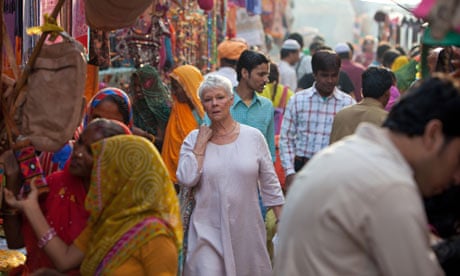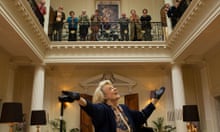Until recently, cinemas were seen as pretty much a no-go zone for older people. There might be the occasional "silver screening" in a teatime slot, but the rest of the time noisy youngsters would hold sway – crunching popcorn, spilling Coke on the floor and texting during the show. On screen, vampires, aliens, superheroes, childish fantasy, gross-out comedy or preposterous spectacle would probably prevail.
All of the above are still in evidence, but different fare has also come to the fore. In The Best Exotic Marigold Hotel a cast of ageing national treasures grapple with the tribulations of later life. Grown-up dramas such as Tinker Tailor Soldier Spy, The Descendants, The Ides of March, The Iron Lady and The Artist have elbowed their way in.
The arrival and success of such films reflects a little-noticed revolution. Older people are returning to the big screen. They want something different, and the industry is trying to give it to them.
Typical of what's coming shortly is Salmon Fishing in the Yemen, in which a scientist finds "late-blooming love" amid dusty wadis. Dustin Hoffman's directing debut, Quartet, will feature a group of opera singers living in a retirement home. It is estimated that around a third of forthcoming Hollywood productions are being made with an eye on older audiences.
The change of tack involved is historic. Cinema's decades-long fixation on young people began in the 1970s. Its once huge working-class audience had defected to television, and the box-office was in crisis. However, teenagers born in the postwar baby boom were acquiring more money and wider horizons. Anxious studios won them over with simple, thrilling and spectacular films including Jaws and Star Wars.
Thus dawned the era of the multiplex, in which the young not only flocked to repetitive franchise movies but spent eagerly on popcorn, soft drinks and spin-off albums and games. Ticket sales recovered and profits soared. In Britain, annual admissions rose from 54 million in 1984 to 176 million in 2002.
Yet cinema's concentration on the young was to prove precarious. Like their own parents, the baby-boomers eventually defected to television, which now offered more mature drama than the big screen. At first, their offspring's enthusiasm kept the cinemas thriving, but then this started to waver.Social networking, gaming and other electronic competitors began to distract young filmgoers. They discovered that if they wanted to watch movies, they could just steal them from file-sharing websites. In Britain, audience levels fell back from that 2002 high-watermark. In America, attendances by 18- to 24-year-olds slumped by 12% in 2010 alone.
The industry tried to head off this threat with films that were even more spectacular, and increasingly in 3D. However, these cost more to make. That meant higher ticket prices, which the young, who no longer felt so flush, began to resent. In any case, ratcheting up spectacle indefinitely began to look creatively implausible. Yet as anxiety grew, the cavalry were arriving from an unexpected quarter. Between 1995 and 2010 the number of over-50-year-old Americans who regularly visited the cinema increased by 68%. In Britain, the proportion of over-45s among regular filmgoers rose from 14% in 1997 to 30% in 2008. These figures reflect a sharp behavioural change.
When baby-boomers become empty-nesters, they refuse to languish on the sofa like their predecessors. Freed from the need for babysitters, they want to go out and enjoy themselves. To them, cinemas seem good value compared with theatres and restaurants, and they recall affectionately their youthful delight in the medium.
Other businesses were quick to capitalise on the grey pound, but cinema was slow off the mark. Hollywood had come to think of older people as "the once-a-year audience". Studios did not even bother to test-screen films on the over-50s. The industry evaluated its performance by weekend opening figures, which left out older cinemagoers, who often prefer to wait and see.
However, older people are now the fastest-growing age-group in the western world. Only a minority of them have already become filmgoers, so there is plenty of slack to take up. Young people on the other hand will not only become proportionately fewer; they are mostly multiplex regulars already, so they offer little scope for growth in the market.
Bit by bit, cinema began to respond to these realities. It had plenty of ground to make up. As Bill Mechanic, the head of Hollywood's Pandemonium Films, put it to Variety: "Audiences have aged dramatically, and movies generally haven't."
Older people have different tastes from the younger people: effects-heavy spectaculars generally leave them cold. In 2010, the highest-grossing films in Britain were Toy Story 3, Harry Potter and the Deathly Hallows: Part 1 and Alice in Wonderland. However, the films attracting the highest proportion of over-55s were The Ghost, Burke and Hare and Made in Dagenham.
Data like this shows that, as might be expected, older people enjoy films about maturity and the past. They are also keen on reality-based material such as documentaries and biopics. Above all, they warm to good stories with rounded characters.
Early attempts to meet these demands were considered heavy-handed by some. Space Cowboys, in 2000, was dubbed by critics "grumpy old men in space". Still, it found a grateful audience. More recently, Red and The Expendables, both of which feature ageing action men, have taken more than £300m between them. The latter carried the tagline, "Still armed. Still dangerous. Still got it."
The silvering screen has dealt successfully with the tribulations of ageing, as in Iris and Away From Her, but greying filmgoers do not insist on age-focused fare. Titles as different as Mamma Mia!, The Queen, It's Complicated, Eat Pray Love, Up in the Air, The Fighter, Black Swan and The King's Speech have all proved popular with older cinemagoers.
"What's been happening over the past couple of years is that there's been a big emphasis on making quality films," says Andrew Myers, the chief executive of Everyman Cinemas. "Undoubtedly, the older audience recognises quality. They see through films that are not so well made."
It is not only the studios that have needed to up their act; the cinemas also face difficulties. Their window of first-run exclusivity is under attack from online streaming and download. However, older film-lovers are less interested in these newer platforms. Understandably, they are now being eagerly wooed. Comfortable bars and lounges have made cinemas more welcoming, and the arrival of digital projection has made their offering more flexible. "What you should increasingly see is cinemas being able to programme a much broader range of films," says Phil Clapp, the chief executive of the Cinema Exhibitors' Association. Esoteric new releases will become more widely available, as well as remastered versions of much-loved classics such as Chariots of Fire.
Boutique chains such as the Everymans have expanded, while locally owned venues offer innovations ranging from gourmet food to armchairs in the circle. Even the multiplexes once shunned by older people are changing. The Vue chain provides special screenings for over-18s policed by staff ready to pounce on any distracting behaviour. It also offers wider seats with extra legroom and Green & Black's chocolate in the foyer. "We're constantly updating the technology and the environment," says Mark de Quervain, Vue's director of sales and marketing.
In the light of such action, admissions are now rising again in Britain. Last year, they reached 171 million, close to that 2002 peak. The production business can also hope for a more sustainable future. Youth-targeted blockbusters have served the industry well, but they impose huge strain. To make just one can cost up to £200m. Ideally, it should earn a lot more back, but one flop can put a whole studio at risk. The resulting nervousness means that past success is copied, and staleness lies in store.
The character-based dramas that older people prefer cost much less to make, and therefore need to earn less. The King's Speech cost £10m. If it had flopped, it wouldn't have mattered too much. In fact, it has taken £260m worldwide. Blockbusters can make much more than that, but they can never deliver that kind of multiple.
Lower costs mean more films can be made. Riskier projects can be pursued instead of tired sequels to past hits, and these may open new creative avenues. Hollywood studios are showing more interest in non-tentpole projects with budgets of less than £30m, but on this terrain, smaller players can also operate. The future looks brighter for imaginative independents and new entrants bringing fresh tricks with them.
Ageing audiences might have been expected to resist novelty. Yet although older filmgoers may like feel-good, sentimental and reassuring fare, they are also ready to be challenged. In Britain, 63% of arthouse fans are over 35.
The future of Britain's own film-makers looks particularly promising. "Where British production generally succeeds is in making richer, deeper, more thought-provoking films," says Alex Stolz, a senior executive at the British Film Institute. "These tend to have quite an older-skewing audience." Older filmgoers are disproportionately supportive of British output, and their enthusiasm is paying dividends. Last year, independently made British films were responsible for an unprecedented 13% of UK box-office takings.
Overall, more varied and locally based fare should make cinema more fulfilling, and help it reclaim some of its lost respect. This may benefit even the light-headed young, as films favoured by older people can end up broadening less developed appetites. At first, 60% of the audience for The King's Speech was over 50, but this changed very quickly. "The first Orange Wednesday was bigger than the opening Friday," says Paul Brett, the film's executive producer. "That's a huge signal that it was already reaching a younger audience."
The most cost-effective films are those that appeal to all age-groups at once. Hence, the industry's holy grail has become the "inter-generational movie". Animations aimed primarily at children have long been laced with sophisticated jokes to keep their parents awake. With Up, however, Pixar took things further. The hero was a 70-year-old man with a walking stick.Some doubted whether children would wear this, but they need not have worried: globally, the film has taken £460m.
"More and more of the movies arriving now have potential for cross-over between the generations," says Mark Batey, the chief executive of the Film Distributors' Association. "Marigold won't just appeal to the over-60s: it has something for everyone. On one level Hugo was a kid's adventure story set in a railway station; on another, it was a reflection on the origins of cinema."
The future may hold not just more films for older people but better films for everyone. During the past few years, there have been signs in Britain that not just the over-45s, but their immediate juniors, the over-25s and the over-35s, are also going to the cinema more often, while the 15-24s remain the keenest fans.
Maybe we are inching towards a cinema that caters for all age-groups at once, as it used to in the 1940s, when audiences were 10 times what they are today . Then, cinemas were the mainstay of communities. Now, a retreat into individualised entertainment has not only been eating away at social life, but dividing the young from the old.
Increasingly, youth and age speak different languages, live in different worlds and enjoy distinct cultural experiences. Tension between the generations is rising for a variety of reasons, but a common space and shared interest might rebuild a rapport. Recently, the BFI has been experimenting with screenings in village halls. "These events really do bring the whole community together," says Stolz. "There, you can see a template for social cohesion."
By wending their way back to our cinemas, the baby-boomers may be doing us all a favour. They could be helping to reconcile young and old. Carry on filmgoing, seniors.










Comments (…)
Sign in or create your Guardian account to join the discussion